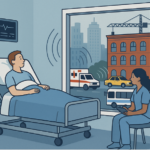By Michael Lentin
Did you know that high decibel noise levels within New York City account for more than 50% of annual 311 complaints? One in four New York residents complain about noise, mostly from pedestrian and vehicular traffic. But the city’s noise levels aren’t just annoying. They also affect your health and well-being. And they’re about to get louder.
NYC will reach 55 million yearly visitors by December 2014, one year ahead of the Bloomberg administration’s projection, the Wall Street Journal reports. Joseph Salvo, Population Division Director at the NYC Department of Planning, agrees that the growth has significantly exceeded expectations.
Part of the reason is that even more tourists are flocking to the five boroughs. Broadway, Times Square, Madison Avenue and more of our landmarks offer limitless options for the spontaneous visitor. Amid these entertainment meccas are loud bus tours, concerts, speaker-fed sidewalk music, outdoor cafes, and lines for bars and nightlife. Interested in fun and relaxation, these visitors surely don’t realize that the logistics required to entertain them cause problems for long-term residents. One tourist’s wild, carefree night out is a property owner’s restless night in.
But tourists aren’t the only reason for the city’s population explosion. New York City’s own local residency has reached an all-time high. The latest statistics released by the Census Bureau in March indicate our boroughs have surpassed 8.4 million people; nearly 2.6 million of those live in Brooklyn alone.
All those residents shop, play, and commute every day, creating roadway blocks, honking horns, sirens, and frustrated drivers. So, how do those increased masses of people and volatile traffic patterns affect you?
Here’s a quick sound and physics lesson, Manhattanites. The threshold of hearing sits at an intensity level of 0 decibels (dB). A normal conversation ranks at an intensity level of 60 dB; busy street traffic is 70 dB. Comparatively, the front rows of a rock concert reach 110 dB.
Shockingly, researchers found that most areas in New York City – even small parks intended to provide quiet, peaceful spaces – exceeded 70 dB. Exposure to more than 85 dB of sound for more than 8 hours in a row is considered hazardous, and can actually lead to hearing loss.
Compounding these already accelerated levels is the Pulaski Skyway closure. This bridge reconstruction project, which began February 2014 and will continue for two full years, has forced more than 34,000 motorists across New York and New Jersey to reroute their daily work commute. Scott Thorn, Project Manager for New Jersey’s Department of Transportation, says that, due to the narrow width of the Pulaski Skyway, both Northbound lanes must be closed rather than shutting down one lane at a time. As a result, cars are being detoured through once-quiet residential areas.
But beyond the noise and aggravation, exposure to the joined forces of environmental, occupational, and recreational noise poses a severe threat to public health. Studies have shown that noise pollution contributes to adverse health effects including anxiety, stress, nausea, headache, emotional instability, neurosis, hysteria, and psychosis. It may even accelerate and intensify latent mental disorders. Noise can, literally, make you crazy.
Not surprisingly, noise is also directly linked to sleep deprivation, a very serious matter. According to WebMD, short-term consequences of sleep deprivation include: decreased performance and alertness, memory and cognitive impairment, stress relationships, poor quality of life, and greater risk of injury. Long-term consequences such as high blood pressure, heart attack, heart failure, psychiatric problems, and growth retardation in children are even more severe.
How can you keep urban noise pollution from affecting your health and enjoyment? Dr. Marehalli Prasad is the Director of the Institute of Noise Control Engineering and an expert in the field of acoustics and vibration. At a Stevens Institute of Technology conference last year, Prasad led a keynote presentation sharing his findings that acoustically designed environments improve the quality of life by lowering interference.
There are steps you can take to reduce intrusive sound in your home and office. Hanging tapestries to absorb sound, laying carpet to reduce floor vibrations, and installing Soundproof Windows are all proven effective ways to protect you and your loved ones from noise pollution.



